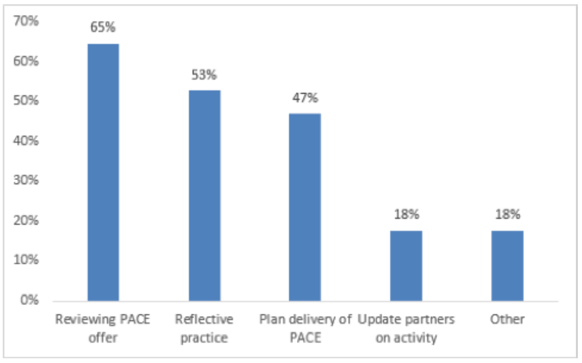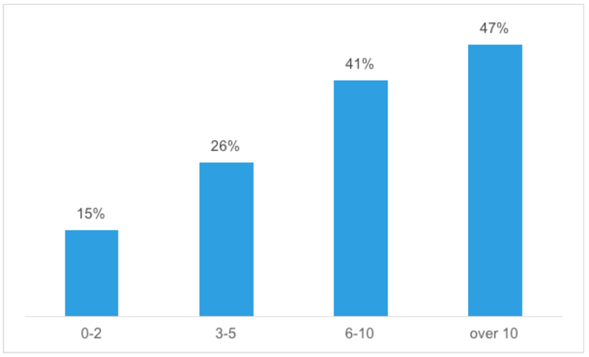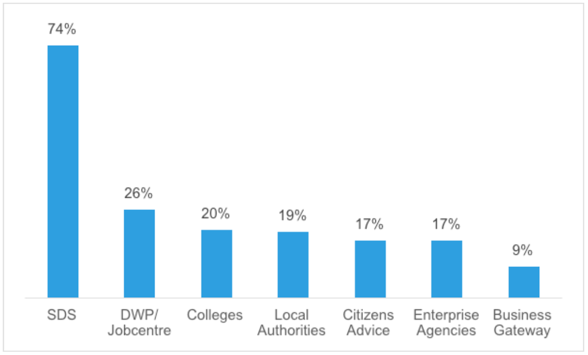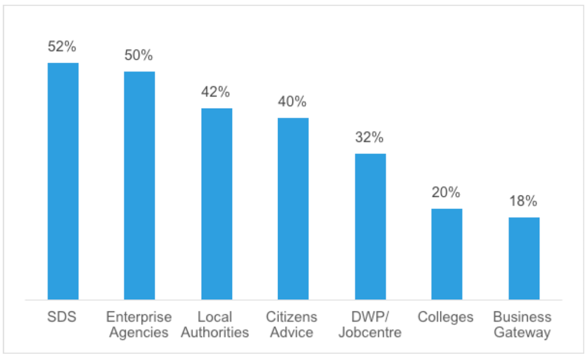PACE partnership review: September 2019
How local PACE partnerships are operating and what current issues they may face.
Partnership Composition And Roles
This section looks at the composition and structure of the 18 Local Partnership Action for Continuing Employment (PACE) Partnerships and what each member contributes to the partnership. It also outlines the mechanics of local partnership meetings and decision-making.
Membership of Local Partnerships
Partnership Chairs
Skills Development Scotland (SDS) is the organisation tasked with organising and managing PACE delivery both nationally and locally. At the local level, SDS provides the Chair and administrative support for the local PACE Partnership, with the Chair taking the pivotal role in both the functioning of the partnership and service delivery. From our interviews and the SDS guidance, the Chair role includes:
- maintaining local partnerships by organising, chairing and recording PACE meetings;
- establishing roles and responsibilities for all partner organisations;
- being the key contact for all information about potential job losses;
- initiating and leading contact with companies requiring redundancy support;
- collating information and updating the central PACE recording system;
- establishing procedures for responding to Scottish Government information requests; and
- coordinating Continuing Professional Development (CPD) activity and sharing good practice.
In addition, SDS PACE Chairs must also coordinate and manage the SDS element of the service delivery as a key part of the partnership.
Member organisations
SDS have collated information on membership from across the 18 partnerships. The different types of organisation involved in PACE delivery are summarised in Figure 1. It shows that Skills Development Scotland (SDS), local authorities, Department for Work and Pensions (DWP), Colleges and Business Gateways are involved across all partnerships. Other significant contributors to local PACE Partnerships across Scotland are Citizens Advice Bureaux and Enterprise Agencies: Scottish Enterprise and Highlands and Islands Enterprise (HIE).
Figure 1 Membership of local PACE Partnerships by type of organisation (2019)
| 2019 | ||
|---|---|---|
| Total number of organisations | % of total* | |
| Local Authority | 32 | 20% |
| College | 24 | 16% |
| Business Gateway | 18 | 12% |
| DWP/Jobcentre Plus | 18 | 12% |
| SDS | 18 | 12% |
| Citizens Advice | 11 | 7% |
| Scottish Enterprise | 8 | 5% |
| Chambers of Commerce | 5 | 3% |
| Community and Voluntary Sector | 5 | 3% |
| HIE | 4 | 3% |
| Training Providers | 4 | 3% |
| Pensionwise | 2 | 1% |
| Library service | 2 | 1% |
| NHS | 2 | 1% |
| HMRC | 1 | 1% |
| Other | 6 | 4% |
| Total | 160 | 100% |
Source: Skills Development Scotland
*Percentage figure represents the percentage of the total number of organisations
From our focus groups and interviews, it is clear that there are very different definitions and classifications of 'membership' among local PACE partnerships. For the most part, local partnerships have no formal partnership infrastructure, and are fairly loosely constituted. Broadly, we have observed three types of member:
Core partners: who are involved in all local PACE redundancy responses. These are essentially SDS, DWP and the relevant local authorities.
Wider partners: organisations who are involved in planning and decision-making meetings and brought into redundancy responses when required. These include Colleges, Enterprise Agencies, Business Gateways, Trade Unions and Citizens Advice Bureaux.
Delivery partners: organisations who may be brought in from time to time to provide PACE related services. They are in contact with the PACE Chair but generally do not attend meetings. (Third sector specialist services, Pensions Advice, NHS Mental Health and Wellbeing services)
The full list of local PACE Partnership members is set out in Appendix A.
Roles and responsibilities
We have summarised the broad roles and responsibilities of the main partner organisations in Figure 2 below. There are variations between local partnership areas, based around the individual representative involved, and the particular services that partners deliver in that area. From our focus groups, differences appear to be most significant within the Local Authority sector.
Figure 2 Broad organisational roles
| Organisation | Main roles |
|---|---|
| Scottish Government | National strategy and communication, chairing of the Ministerial PACE Partnership. |
| SDS | Chairing PACE Partnerships, communication, careers advice and guidance, job-search, employability and vocational training, employer support. |
| DWP/Jobcentre Plus | Benefits checking and advice, employer liaison, employability training. |
| Local authorities | Employability, economic development, financial inclusion, advice and support, equalities and social care support. |
| Scottish Enterprise/Highlands and Islands Enterprise | Business support; particularly for Account Managed and priority sector businesses. |
| Business Gateway | Business start-up advice. |
| Colleges | Employability and vocational training. |
| Citizens Advice | Employee rights, money and welfare advice. |
All partners have a responsibility to share information and intelligence about key labour market issues or redundancies with the PACE Chair.
Formal partnership agreements and protocols
The majority of local PACE Partnerships do not have any formal partnership documentation such as agreements or protocols; operating instead as 'virtual partnerships'. However, Forth Valley PACE Partnership has a written PACE protocol setting out roles, processes and providing useful contact information. It covers:
- Membership: including key contact names
- Roles and responsibilities
- Procedures
- Funding
- Meetings
Partners in Forth Valley viewed the partnership protocol document as a useful reference point, particularly for induction of new staff and at handovers.
Membership changes and review
Most of the local PACE Partnerships had undergone some changes in organisational membership over the years; and many were in the process of continuing change to varying degrees. Member organisations who are no longer involved in some local partnerships include Trade Unions and HMRC. Trade Unions are involved at the national level and get involved locally on a case by case basis. HMRC are also still involved at the national level. While Citizens Advice are involved in most areas, they have stopped involvement in some partnerships.
There is generally no formal approach to reviewing the partnership, its composition, roles and responsibilities. One partnership is currently planning a review process, prompted in part by service changes within the local authority.
Partnership meetings
Frequency of meetings
From our survey, it is clear that most local PACE Partnerships do not have formally structured meetings scheduled, with 70% of Chairs holding meetings only where they are required. The other 30% held formal meetings occurring quarterly. Several of those holding quarterly meetings have moved, or are in the process of moving, to less frequent meetings. In one area where we held a focus group, Local Partnership meetings used to happen quarterly but now take place every six months after agreement from partners. Additional meetings can take place if required, although members meet in different PACE and non-PACE circumstances outside of the formal meetings (e.g. Local Employability Partnership).
Another PACE Chair commented that:
'Due to a reduction in PACE delivery involving partners we decided to move to a schedule where we would not meet quarterly as had been the case for a number of years. We moved to a six-monthly frequency, however several partners did not attend and because of this I decided in consultation with partners that we would meet only when there was a recognisable need. Our partnership was very well-established and up until recently we had longevity in membership and partners understood our protocols and Scottish Government expectations around PACE.'
And another made similar comments:
'There are no regular meetings for all PACE Partners, but I meet/communicate with the key partners when there are redundancy situations pending if appropriate. Communication also takes place via email and telephone calls. Most of the partners are members of the local Employer Engagement group and we meet regularly - we have considered having PACE updates as an agenda item at some of the meetings.'
Smaller, more rural partnerships are less likely to have any formal partnership meetings. There are several inter-related reasons for this including:
- members have mature relationships and are regularly in contact with each other through non-PACE activity;
- PACE redundancy instances are sporadic and unpredictable; and
- logistical and travel limitations mean that members prefer to hold more practically focused PACE meetings where they are actively working together.
As one commented:
'There is a distribution list of PACE Partners and they are contacted when there is a PACE need. It is in effect a virtual group. We would rather spend time on a demand basis from clients rather than in meetings. Partners meet and discuss the partnership at PACE events. Occasionally a manager will be phoned for an update.'
However, in some partnerships, staff and organisational changes have led to this approach becoming less effective, with the key contact losing touch and PACE work being passed from person to person. The breakdown of mature relationships due to staff and organisational changes will affect the ability to work in this way. From the survey responses, it is clear that an ad hoc approach to meetings does not work for all partners.
'We only seem to get together when there is a crisis.'
'Partnership comes together to meet emerging needs. Preference would be to meet on a regularly scheduled basis to share examples of good practice and to identify areas for improvement.'
'Hold PACE meetings regularly to share intelligence and plan for potential closure and redundancies. All partners actively involved and clarity of roles regarding who is coordinating what and how feedback is provided.'
'I think it would be beneficial to have local partners meet up to discuss what we each deliver and encourage stronger working links - where possible.'
A third of PACE Chairs would like there to be more formal meetings of the Local PACE Partnership. All but one of these currently have no formal meetings. Overall 38% of Chairs do not hold scheduled meetings and do not identify a need to, a further 31% hold no meetings but would like to, and 31% currently have scheduled PACE Partnership meetings. So, there is some appetite for more regular formal meetings, although a substantial minority who are happy with the current approach. Those identifying the need for further meetings feel that their purpose should focus on:
- understanding each partner's role and remit, including any changes to what partners deliver;
- sharing learning, reflecting on previous redundancy situations; and
- updates on activity.
While not universal, there is a sense among some partnerships that services and funding are going through a significant period of change at the moment. This seems to be particularly affecting the Local Authority sector and the funding available for training. In at least three local partnership areas, the representation, roles or services of local authorities had recently changed in relation to PACE. These changes have included reductions in funding for money advice, equalities and elements of employability support. In two of these areas, service changes have resulted in the loss of representatives at PACE Partnership meetings. The imminent introduction of the new South of Scotland Development Agency will lead to more changes in the two partnerships covering the rural south. Changes to funding around employability and the uncertainty over European Structural Funds post-Brexit is also affecting the stability of employability partnerships.
Purpose of the meetings
When asked about the purpose of the meetings, the most common response provided by Chairs was reviewing the PACE offer, which around two thirds of PACE Chairs identified (65%). As Figure 3 shows, just over half used meetings to reflect on good practice and learning (53%), and just under half focused on PACE delivery (47%).
Figure 3 Purpose of partnership meetings

Source: Local PACE Partner survey 2019 (n=17)
The other category included:
- ensuring partners are familiar and supportive of our PACE response protocol;
- providing partner updates that are relevant to the PACE offer; and
- share PACE reports/feedback on PACE activity/partner updates/relevant speakers
Change of PACE Chair
It seems that the informal approach works well when existing personnel are well-established, and relationships are strong. However, the lack of formal meetings is frustrating for those who are relatively new to the role and perhaps do not have the knowledge and relationships that more experienced Chairs rely on. One interviewee had inherited the approach from the previous Chair but was struggling to get contact and involvement from some partners. She highlighted that the lack of structured meetings did not help with this situation and had led to a lot of effort to engage and involve partners.
Training needs
Induction
In several of the Focus Groups we conducted, new personnel had become involved in the local PACE Partnership over the past few months. Induction approaches were mostly informal combining a handover within their own organisation, some shadowing of the PACE role and a session with the PACE Chair. The consensus appeared to be that this approach was adequate.
The PACE protocol agreement that is in use in one area sets out the recommended SDS induction process for new PACE Chairs, which should include:
- one-to-one meetings with all local PACE partners;
- training on the online SDS spreadsheet;
- meeting all local PACE advisers; and
- meeting with members of the National PACE team.
Of the 27 survey respondents who said they had been involved in PACE for less than two years, only 15% said they had received specific training relating to PACE support.
Training for PACE
In our survey of PACE Partners, we asked respondents whether they had received any training for their role in delivering PACE support. Overall, 31% of respondents stated they had received training. Whether or not members had received training appears to be linked to their length of involvement, with those who have been delivering PACE services for more than five years much more likely to have received training. As Figure 4 shows, nearly half of those who had been delivering PACE support for more than ten years had received training (47%), compared with only 15% of those involved only over the past two years.
Figure 4 Whether they had received training by number of years involved in PACE support

Source: Local PACE Partner survey 2019 (n=114)
Three quarters of SDS staff who are involved in PACE delivery have received training (74%). However, the situation is very different among other organisations. Around a quarter of DWP/Jobcentre staff have received training (26%), around one in five College representatives (20%) and a similar proportion of Local Authority respondents (19%)
Figure 5 Whether received training around PACE delivery by organisation type

Source: Local PACE Partner survey 2019 (n=113)
And, among respondents to the partner survey, more than a third would like to have more training around PACE (37%). Perhaps not surprisingly, there is greater demand for training among those who have more recently become involved, with this figure increasing to 46% among those with less than two years' experience who are least likely to have received PACE training.
By organisation type, the highest demand for more PACE related training is among SDS (52%) and Enterprise Agency (50%) staff as Figure 6 shows. However, there is also a significant demand for training among Local Authority (42%) and Citizens Advice Bureau (40%) staff. Around a third of DWP/Jobcentre staff would like more training (32%); and the lowest demand is among College staff (20%) and Business Gateways (18%).
Figure 6 Proportion who would like more PACE training by organisation type

Source: Local PACE Partner survey 2019 (n=112)
Of those who said they would benefit from additional training, the most commonly identified need was around the PACE offer, who is involved, and what each partner delivers. There is a strong positive correlation between these 'training' needs and the content and purpose of formal partnership meetings. Of the six PACE Chairs identifying further training needs, five also identified a desire for more scheduled meetings.
Other suggestions include benefits, money advice, funding streams and the redundancy process. There appears to be a strong demand for information on the rules and processes around redundancy and on some of the recent changes to the benefits system. Some examples cited from the survey include:
'benefits and redundancy packages received by PACE clients, and which may affect any support provided by our organisation. How these benefits and other financial packages affect DWP benefits.'
'Eligibility criteria for programme support - what provision can we access and how do we link with other contracted provision.'
'Understanding redundancy process - specifically employee's rights, employer obligations, what happens when no HR dept or when company closes suddenly.'
'More visible funding streams for retraining. Access to meaningful LMI on LOCAL, current skills gaps, skills in demand, vacancies, how employers tap into the newly available skilled workforce following redundancies at other companies.'
There were also some specific skills identified as training needs including:
- networking skills;
- diplomacy and negotiating skills;
- more information on how recruitment companies operate in 2019;
- latest thinking on CV preparation - achiever versus doer CVs; and
- effective use of social media: for example; Advanced LinkedIn modules to help with building effective networks.
Contact
Email: margaret.sutor@gov.scot
There is a problem
Thanks for your feedback